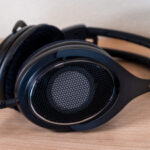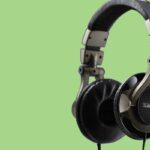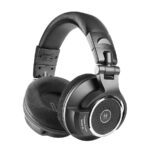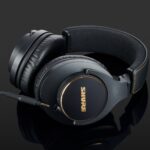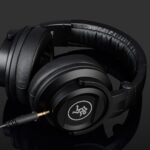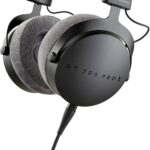Complete review of Pioneer HDJ-S7 on-ear DJ headphones with comprehensive frequency analysis and audio testing. Professional evaluation for DJ, production, and versatile listening applications.
Pioneer HDJ-S7 DJ Headphones Review: Accurate Sound Beyond the Booth
DJ headphones typically carry reputations for excellent isolation combined with exaggerated bass response—characteristics addressing specific environmental and genre demands of DJ performance. The Pioneer HDJ-S7 on-ear headphones enter this market with the established Pioneer brand behind them, but can DJ headphones deliver accurate enough sound for critical listening and music production beyond the club?
Understanding DJ Headphone Requirements
Before examining the HDJ-S7 specifically, understanding the unique challenges facing DJ headphones provides essential context. DJs working in club environments face high ambient noise levels, predominately bass-heavy electronic music, and demanding physical conditions from frequent transport and active performance.
The common assumption holds that all DJ headphones over-emphasize bass and treble to compensate for environmental factors and genre characteristics. While this describes many consumer-oriented DJ headphones, professional models often pursue more balanced approaches. Great DJs seamlessly blend tracks recorded in different studios on different equipment by different producers—a task requiring accurate frequency monitoring despite beat synchronization.
The HDJ-S7 represents Pioneer’s attempt to provide DJs with monitoring tools that deliver accuracy alongside the durability and isolation expected in professional DJ applications.
Frequency Response: Sine Wave Analysis
Comprehensive sine wave testing from 20Hz to 20kHz reveals the HDJ-S7’s fundamental frequency characteristics. Both linear and logarithmic analysis provide insight into how these headphones shape audio across the spectrum.
The linear response curve shows lower frequencies receiving slight over-emphasis—not dramatic but noticeable. Midrange and high frequencies appear accurately represented in the linear view, though the logarithmic analysis provides more relevant information about perception.
Logarithmic analysis confirms slight emphasis in lower frequencies with notably accurate mid and high representation. This tuning philosophy proves interesting for DJ applications—the modest bass boost could compensate for incomplete seal during active performance when headphones aren’t always positioned perfectly.
In DJ environments, maintaining perfect headphone placement proves challenging during performance. The slight bass emphasis might actually result in more accurate perceived response when seal isn’t optimal, compared to perfectly flat headphones that would lose bass disproportionately when seal breaks.
The accurate midrange reproduction particularly stands out. Many DJ headphones sacrifice midrange accuracy for exaggerated extremes, but the HDJ-S7 maintains balanced mids that support accurate tonal evaluation across full mixes.
Music Reproduction Performance
Moving beyond single-frequency testing to complex musical content reveals how the HDJ-S7 handles real-world material. Music incorporates simultaneous frequencies creating interactions that expose response characteristics not apparent in sine sweeps.
Linear analysis of music playback confirms slight bass emphasis without excessive boom or muddiness. The midrange appears slightly under-emphasized initially, though this perception stems partially from the modest bass boost rather than actual midrange absence.
Crucially, subjective listening reveals these headphones don’t exhibit the scooped, hollowed-out character common in bass-heavy consumer headphones. All midrange content remains clearly audible and distinguishable—essential for critical mixing decisions and track blending.
The logarithmic comparison reinforces these observations. The slight bass emphasis appears clearly, potentially creating minor perceived midrange recession, but all frequencies remain present and accessible. For DJ applications involving track matching and blending, this accuracy proves invaluable.
Engineers could confidently mix on the HDJ-S7 despite their DJ-oriented marketing. The frequency response proves accurate enough for informed decisions about EQ, balance, and overall mix tonality—though users would need to account for the modest bass boost as with any colored monitoring tool.
Spoken Word Evaluation
While DJs primarily monitor music, understanding voice reproduction provides insight into overall accuracy and potential versatility for other applications. The HDJ-S7 handles spoken word material with reasonable fidelity, exhibiting similar characteristics to music reproduction.
Linear analysis shows slight bass emphasis with expected high-frequency characteristics. Subjective listening reveals slight scooping in voice reproduction—noticeable but not severe enough to undermine voice monitoring applications.
The logarithmic analysis confirms slight midrange under-representation, though the deviation remains modest—measured in small decibel amounts rather than dramatic coloration. For voice monitoring in podcast production, audiobook evaluation, or voice-over work, the HDJ-S7 provides adequate accuracy.
The enhanced bass falls mostly below fundamental voice frequencies, minimizing impact on vocal timbre. The slight midrange recession affects voice character modestly without dramatically altering tone or intelligibility.
Content creators seeking versatile headphones for both music and voice applications could employ the HDJ-S7 competently across both domains, though dedicated studio monitors might provide slightly more neutral voice reproduction.
Gaming Audio Performance
Though clearly designed for DJ applications, gaming evaluation provides insight into spatial reproduction and versatility. Many users seek headphones serving multiple purposes beyond their primary design focus.
The HDJ-S7 performs adequately for gaming without exceptional positioning precision. The spatial representation registers clearly enough for casual and moderate gaming, with environmental sounds and directional cues coming through comprehensibly. The controlled bass prevents muddiness that obscures important audio information in complex game soundscapes.
For competitive gaming where audio positioning provides tactical advantages, purpose-designed gaming headsets might offer advantages. For DJ or music users occasionally gaming, the HDJ-S7 proves entirely suitable without requiring separate gaming-specific headphones.
Build Quality Excellence
Build quality represents perhaps the HDJ-S7’s most impressive characteristic, suggesting genuine professional pedigree beyond marketing claims. The construction combines metal components throughout with strategic plastic elements, creating headphones that feel substantial and durable without excessive weight.
The metal headband extends continuously around the frame, providing excellent structural integrity and flexibility. The adjustment mechanisms employ metal hardware as well, with stepped positions that lock securely. These serviceable adjustments attach with screws, enabling repair or replacement if components loosen or fail—design consideration showing commitment to long-term professional use.
The silicone headband padding provides adequate comfort without excessive thickness. The lightweight overall design reduces need for heavy padding, as balanced weight distribution prevents pressure concentration.
The ear pads utilize soft leather material that seals effectively against ears, contributing to the excellent isolation. The clamping force achieves ideal balance—firm enough for secure fit and proper seal without creating fatigue during extended wear. For on-ear designs, this comfortable, secure fit proves essential for both sound quality and long-term wearability.
The ear pads provide adjustment capabilities including less than 90-degree side-to-side rotation plus substantial vertical adjustment. This range accommodates diverse fit preferences and single-ear monitoring positions common in DJ applications.
The detachable cables feature locking mechanisms preventing accidental disconnection during performance—users will appreciate or dislike this depending on preference. Two cables come standard, including coiled design favored by many DJs. One consideration: the coiled cable features 90-degree connector rather than straight plug, which some users might find less convenient.
Quarter-inch adapter accompanies the headphones, providing compatibility with professional DJ and studio equipment. Overall build quality genuinely impresses, suggesting these headphones will withstand years of professional use.
Technical Specifications
The HDJ-S7 employs 40mm dynamic drivers with 5Hz to 40kHz frequency response—substantially broader than the 20Hz-20kHz range of human hearing. This extended response contributes to the headphones’ ability to reproduce low-frequency content that’s felt as much as heard, while also providing air and space in the ultra-high frequencies.
As closed-back on-ear headphones, the HDJ-S7 provides excellent sound isolation essential for DJ booth environments with high ambient noise. The lightweight design weighing just a few ounces makes them suitable for extended performance sessions without neck or head fatigue.
The impedance and sensitivity specifications ensure compatibility with DJ equipment, mixing consoles, smartphones, and any other source devices without requiring specialized amplification.
Applications Beyond DJing
While Pioneer markets the HDJ-S7 as DJ headphones, the testing reveals capabilities extending well beyond DJ booths. The accurate frequency response makes them suitable for music production, mixing applications, and critical listening across diverse genres.
For everyday listening, the modest bass boost and accurate midrange create enjoyable sound reproduction across music styles. The lightweight design and comfortable fit support extended listening sessions for commuting, travel, or recreational music enjoyment.
The isolation proves valuable in noisy environments—public transportation, busy offices, or crowded spaces where environmental sound would interfere with listening. The closed design prevents sound leakage that would disturb others in quiet environments.
Podcasters and voice content creators could employ the HDJ-S7 for monitoring, though the slight midrange recession suggests dedicated studio monitors might prove more optimal for voice-focused applications.
Target User Recommendations
Ideal for:
- Professional DJs requiring accurate monitoring for track matching
- Music producers seeking durable, portable headphones for mobile production
- Users wanting one versatile set for DJ work, production, and casual listening
- Anyone prioritizing build quality and long-term durability
- Listeners seeking closed isolation with accurate frequency response
Consider alternatives if:
- You require absolute flat response for critical mixing (though these come close)
- On-ear design doesn’t suit your comfort preferences (try before buying)
- You need headphones exclusively for non-DJ applications (might pay for unused durability)
Value Assessment
At competitive pricing within the professional DJ headphone segment, the HDJ-S7 delivers excellent value. The build quality alone justifies significant investment for users requiring durable professional equipment. The accurate sound reproduction provides value beyond typical DJ headphones, creating versatility across multiple applications.
Compared to consumer DJ headphones emphasizing style over substance, the HDJ-S7 represents professional-grade equipment designed for demanding use. Compared to other professional DJ models from Sennheiser, Audio-Technica, and others, the Pioneer competes effectively on both performance and value.
Final Verdict
The Pioneer HDJ-S7 succeeds at its primary mission while offering unexpected versatility for applications beyond DJ performance. The accurate frequency response—particularly the balanced midrange—sets these apart from typical DJ headphones that sacrifice accuracy for exaggerated extremes.
The exceptional build quality inspires confidence in long-term professional reliability. These represent headphones that will withstand years of demanding use while maintaining performance and comfort.
For DJs specifically, the HDJ-S7 provides monitoring tools that support accurate track matching and blend decisions. The slight bass emphasis addresses practical seal considerations without overwhelming the accurate midrange that makes critical listening possible.
For producers, content creators, and music enthusiasts, the HDJ-S7 offers durability and isolation in packages delivering surprisingly accurate sound reproduction. While marketed as DJ headphones, they function capably across diverse applications where closed design and accurate response prove valuable.
The Pioneer HDJ-S7 demonstrates that professional DJ headphones need not sacrifice accuracy for application-specific features. These represent genuinely versatile tools suitable for discerning listeners across multiple contexts—DJ booth, production studio, and everywhere between.




